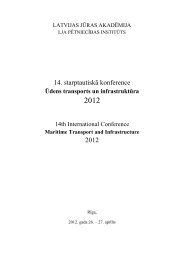Latvian Maritime academy
Latvian Maritime academy
Latvian Maritime academy
You also want an ePaper? Increase the reach of your titles
YUMPU automatically turns print PDFs into web optimized ePapers that Google loves.
Training curriculum and pedagogical affairs in all MET institutes globally still exists. Hence the officers<br />
and engineers regardless of any nationality can still perform as equal. However, social and economical<br />
affairs might enable some to be trained perfectly, while others are deprived from proper training and<br />
education.<br />
Figure 1. Serious casualties by vessel type within the period from 2006 to 2010<br />
Source: Lloyd's List Intelligence 2012<br />
Tankers are primarily the major haulers of oil. Tank vessels are constructed or adapted to carry oil or<br />
hazardous material in bulk as cargo or cargo residue. The earliest construction of tank vessels used single<br />
hulls. There are various types of tankers: oil tanker, parcel tanker (chemical vessels), combination carrier<br />
(designed to carry oil or solid cargoes in bulk), and barges. In addition, there are international bulk<br />
chemical codes governing the safe transport of chemical cargoes and providing various levels of<br />
protection against the uncontrolled release of substances that pose the greatest environmental risk.<br />
Tank vessels are classified by the trade in which they normally operate over a period of time. The<br />
three most common categories are, firstly, crude oil carriers, secondly, product carriers, which can carry<br />
clean (e.g., gasoline, jet fuel) and dirty (e.g. black oils) carries, and thirdly, parcel carriers (chemicals).<br />
Tankers tend to remain in one trade but market conditions can dictate a change, even though the process<br />
to change a vessel's trade involves extensive work.<br />
Crude carriers are classed as either VLCCs (Very Large Crude Carriers) or ULCCs (Ultra Large<br />
Crude Carriers) and are designed to transport huge quantities of crude oil over many long and heavily<br />
travelled sea routes. The appropriate economies of scale depend on the area from which the oil is being<br />
shipped. In addition, "lightering," offloading or transferring oil from large tankers to smaller ones, a<br />
process which can move 1,000 barrels per hour, are used so that the smaller vessels can enter smaller<br />
ports that the larger vessels cannot.<br />
Historically, most of the nation's tanker fleets were built as single-hull vessels, i.e., a single layer of<br />
steel made up the hull. As ships and barges is a major link in the country's oil transportation network,<br />
both for transporting crude oil to U.S. refineries and for transporting refined oil products to market, the<br />
Oil Pollution Act (OPA) of 1990 made extensive changes designed to make these shipments<br />
environmentally safer. One change requires the phasing out of all shipment of oil cargoes in single-hull<br />
vessels in U.S. waters from 1995 to January 1, 2015, with the oldest and largest vessels phased out first.<br />
After January 1, 2015, only double hull vessels may be used. There are also European standards in this<br />
area with the Regulation of the European Parliament and of the European Council/Commission on<br />
Legislative Documents amending Regulation EC No. 417/2002 on the accelerated phasing-in of doublehull<br />
or equivalent design requirements for single-hull oil tankers.<br />
One of the major concerns in the safe transport of bulk liquid cargos by tank vessel is the stress on<br />
the hull. Bending in the form of sagging (concentration of weight in the mid section of the vessel causing<br />
the deck to be subjected to compression forces while at the same time the keel is under tension), hogging<br />
(concentration of weight at both ends of the vessel causing the deck to experience tensile forces while the<br />
keel is under compression), and shear force, which occurs when two forces act in opposite directions<br />
parallel to each other, such as at a bulkhead between an empty ballast tank and a full cargo tank. The<br />
weight or gravitational and buoyant action experienced on either side of the bulkhead causes the shear<br />
force phenomenon.<br />
The development of the super tanker came about due to an array of factors including Middle East<br />
hostilities that led to the closure of the Suez Canal, nationalization of oil fields in the Middle East, and<br />
29
















